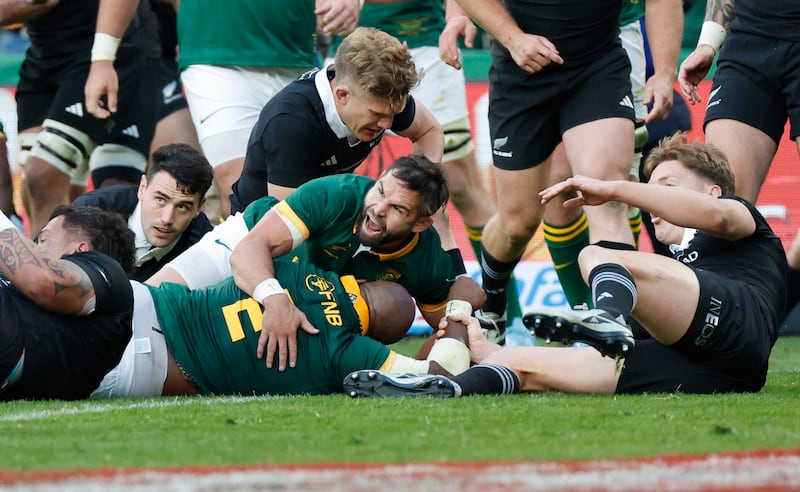Let me lay out my case for the need to reform the use of technology by referees and TMOs as bluntly as my Australian upbringing will permit.
During last year’s Rugby World Cup quarter-final and final, two of the game’s best referees, Ben O’Keeffe and Wayne Barnes, awarded penalties that helped determine the outcome of those games. In my opinion both decisions were wrong.
This is not a criticism of these two excellent referees. Officiating in rugby is exceptionally difficult. Referees are required to make hundreds of decisions in every match and they overwhelmingly get the majority of those decisions right almost all of the time.
When human error occurs, which understandably will happen, officials must be supported with the available technology to be empowered to change their decisions to deliver justice.
The Counter Ruck: the rugby newsletter from The Irish Times
Italy v Ireland: Injury-free Aoibheann Reilly to start as Irish side look for rare win on the road
‘I had to just go all-in:’ How Josh Ioane has embraced the Connacht mentality
Ulster beat Stormers in high-scoring classic to make it three wins in a row
During RWC 2023 both of these decisions resulted in vital penalty goals during games that both decided by a solitary point.
Kwagga Smith earned the vital quarter-final kick for South Africa against France at the breakdown, while in the final, New Zealand’s Ardie Savea was penalised by Wayne Barnes in the jackal, when it was decided his hands touched the ground first.
On both occasions, when replays were shown at home and in the ground, everyone watching could see what had played out. The mistaken decision seemed clear to me. Presumably the referee in the stadium had the same thought if he looked at the big screen.
But the Springboks’ Handre Pollard was still allowed to line up his penalty kick. This is because currently referees are unable to review their actions and use real-time video evidence to correct an unjust penalty, even when it is clear that they have made an error.
The law must be changed to empower the TMO to instruct the referee to review a penalty decision when the evidence is immediate and clear that an error has likely been made (currently the TMO cannot intervene on penalty decisions, only on tries and foul play.)
If this was the case both of the above decisions would have been reversed because the video evidence of human error was clear. The technology could have empowered the officials to deliver justice.
O’Keeffe and Barnes were victims of an inflexible refereeing system that is not implementing available technology to support referees in getting their decisions right.
For instance, current ball-tracking technology records the movement and the position of the ball during a match. This technology should be provided to TMOs to deliver the exact position of the ball when the limited scope of TV cameras cannot.
At least twice in major games over the last season, this technology could have delivered justice.

During the dying seconds of this year’s Six Nations match at Murrayfield, Scotland were denied what they believed was a match-winning try against France. Because a player’s leg obscured the only camera angle that could have verified the grounding of the ball, the try was denied.
The Scots were incandescent when their belief that they had scored could not be proved by the evidence at the disposal of the TMO.
Last week I consulted an expert in match analysis who said that in his opinion ball- tracking technology should be used to inform the TMO of the exact location and movement of the ball.
He believed this technology could have provided the information for the officials to make a just and accurate decision on the try at Murrayfield.
He also believed that ball-tracking technology would have eliminated any argument over the highly-controversial try awarded to the Springbok hooker Bongi Mbonambi in the recent Test at Ellis Park against New Zealand.
New Zealand’s Jordie Barrett made what seemed to be a try-saving grapple that dislodged the ball from the hands of the Springbok hooker as he was driving downwards attempting to score a try.
Irish referee Andrew Brace was unsighted and awarded the try before calling for the TMO to adjudicate.
The world waited for Ireland’s Brian MacNeice, the TMO, to ratify that Mbonambi had lost possession while seemingly short of the try line. Kiwi jaws dropped and outrage began as Mbonambi was awarded the score.
In defence of MacNeice’s decision, the law states: “It is a knock-on when a player, in tackling or attempting to tackle an opponent, makes contact with the ball and the ball goes forward.”

If Barrett did knock the ball on then the TMO’s decision was correct. However, the law also states that it is not a knock on, “if a player rips or knocks the ball from an opponent and the ball goes forward from the opponent’s hand or arm”.
Having replayed that try many times, in my opinion it appears that Barrett does not knock the ball on, but rather knocks it down, and it is Mbonambi’s forearm that propels the ball forward, creating a knock-on.
If this is the case then the try should not have been awarded.
Let us spare a thought for the difficulty presented to the TMO. The ball movements in this situation are so minute that they can only be seen in the slowest of slow motion replays and the arguments for ‘try or no try’ are raging back and forth. The TMO had to make a rapid decision under the greatest of pressure, and also, I would argue, without being supplied with all the facts.
The rugby analyst I consulted believed ball-tracking technology could have been able to support the TMO decision one way or the other. We both felt that the ruling of a Barrett knock-on in the tackle was questionable.
But here is the heart of the matter. If the officials had been supplied with the available technology and been empowered to use it, all of these decisions may have been changed, and all the teams that lost may have won.
The difficult mission of officials is to deliver justice within the laws. Currently, the game is not empowering them to maximise the use of available technology to fulfil that mission.
After enduring decades of officiating errors, the rugby community has become desensitised to these, and so many other failures in the game’s laws and how they are implemented. Instead of striving to improve the system, we explain away obvious failures as “human error”. The point is that these human errors can be greatly minimised with the use of technology and by empowering our officials to use it. So why aren’t we doing it?

















